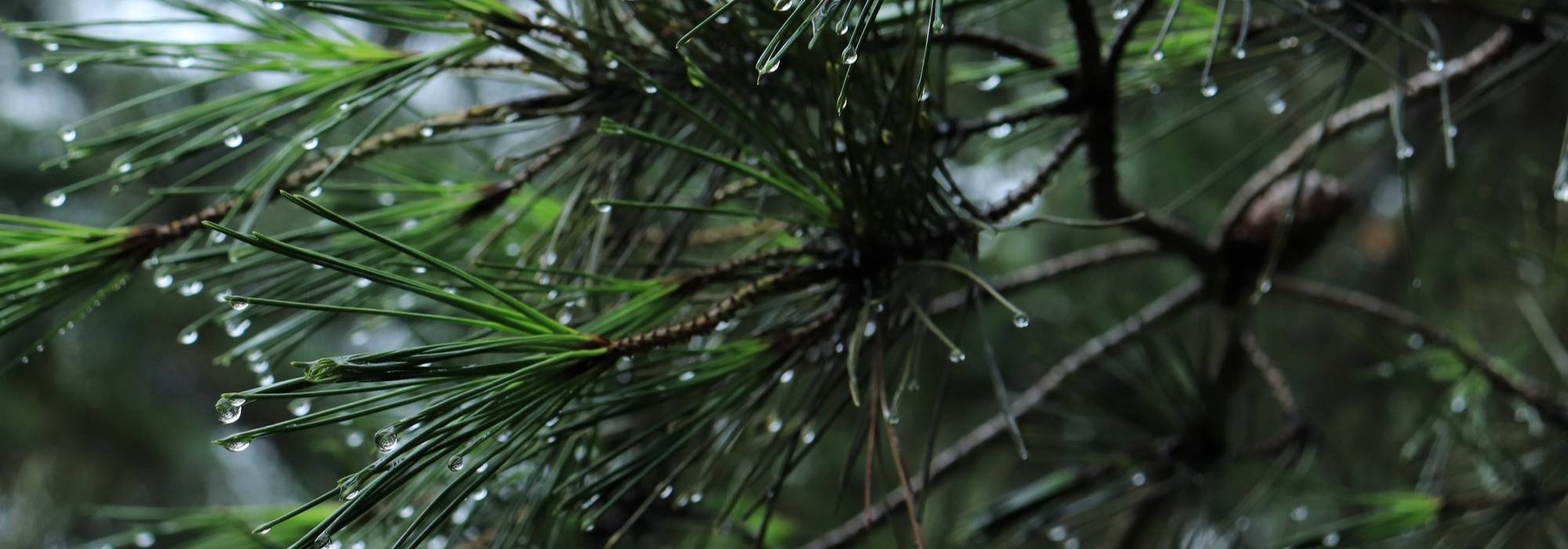
Pines: planting, pruning and care
Contents
Pine, in a nutshell
- Pines are conifers widely used in gardens for ease of cultivation and their picturesque silhouette, such as umbrella pine or dwarf forms.
- Pines selected for slow growth offer very diverse growth habits, colours and textures that can be paired with flowering rockery plants, grown in a pot or pruned into bonsai.
- Pines are conifers accustomed to living under extreme conditions of wind, drought, cold and scorching sun.
A word from our expert
The genus Pinus (family Pinaceae) is one of the most important among conifers, with more than 120 species, since it includes major forest trees such as maritime pine (Pinus pinaster), Scots pine (Pinus sylvestris), black pine (Pinus nigra). It is among Californian pines that the world’s most venerable trees are found, with Pinus longaeva of the Great Basin aged 5,000 years.
Ordinarily, pines are reserved for very large gardens, as they tend to thin out at the base as they age and to occupy a wide area when planted as specimens. Moreover, recent severe storms in France that uprooted a number of pines planted close to houses have prompted owners to fell them and to be cautious about planting this species, however majestic it becomes with age, notably umbrella pine.
Today many cultivars of modest-sized pines have been developed and can safely adorn a small garden, a rockery or even a large pot. Their outline, which can be easily shaped in the manner of bonsai, and their tolerance of repeated pruning of small shoots, allow owning a pine whatever region and urban or rural setting. These forms are both compact and elegant thanks to fineness of needles.
Pines have a very ancient origin on Earth as they predate flowering plants and date from the Cretaceous (130 Ma). More than 120 species still survive, which demonstrates their strong adaptability to a wide range of ecological conditions.
Pine wood is generally fairly soft due to rapid growth of the tree, sometimes very resinous, and is used for timber and paper pulp production. France’s largest forest is the Landes forest, composed of maritime pine (Pinus pinea), due to drainage of the marshes which produced a poor sandy, very acidic and infertile soil that nonetheless suited this species.
Description and botany
Botanical data
- Latin name Pinus
- Family Pinaceae
- Common name Pine
- Flowering between April and July
- Height between 2 and 60 m
- Exposure sun
- Soil type any loose soil, well drained, even calcareous
- Hardiness Good to excellent (-15 °C and above)
Pines make up a genus of conifers easily identifiable by their needles gathered in vascular bundles of 2, 3, 5 (sometimes up to 8) at the end of a short branch. However, a needle may occur singly, as in American pine Pinus monophylla. Vascular bundles of needles are always arranged in a spiral around the branch and never opposite.
Pines are the most complex and diverse genus among conifers. New species continue to be discovered in Mexico and the Far East. The genus is present in almost all regions of the Northern Hemisphere, except northern Africa (apart from its extreme north), under temperate, arctic, subtropical or tropical climates. There is a strong concentration of different species at elevations in Mexico, in California and in China, although species planted in France are most often native, such as Scots pine, black pine with its many subspecies (Corsican laricio, Salzman, Austrian now naturalised throughout Europe) or maritime pine (the latter is entirely dedicated to timber production).
Medium- and large-sized pines have a pyramidal habit until the tree reaches maturity. The leading shoot is prominent and establishes a new nival zone of branches arranged in a star around the trunk each season. This makes it easy to determine the age of a juvenile tree. Branches end in an erect bud whose size, colour and shape (rounded, elongated) and resin presence vary by species.
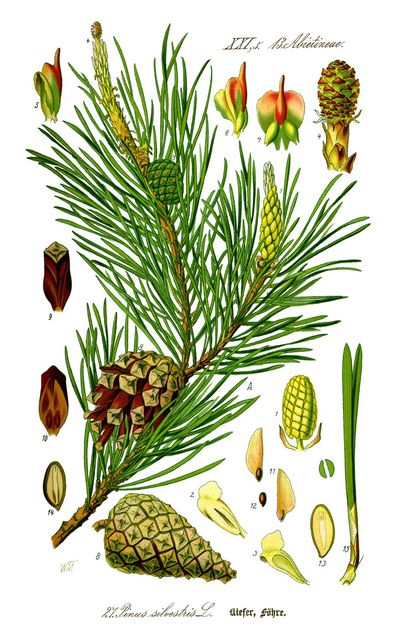
Pinus sylvestris – botanical illustration
Bark of pines is often remarkable, as with umbrella pine which displays a patchwork of grey, orange and brown tones, Napoleon pine (Pinus bungeana) with its khaki-beige camouflage look, black pine with its silvered and ochre fissured bark, Scots pine (the most cultivated pine in Europe) recognisable by the vermilion hue of its bark at the crown, contrasting with its blue-green needles… Rooting is often fairly shallow, which explains why in waterlogged soil the pine can topple easily with its root plate during strong gusts.
Needles are evergreen which means the tree is never bare, except in case of fierce attack by processionary caterpillars! However, older needles fall after 3 to 10 years depending on species and form a litter layer that takes a long time to break down in acid soil. Needle length and thickness give the tree a more or less graceful appearance. Pinus griffithii, strobus bear vascular bundles of five long, drooping bluish needles that give the tree a supple, graceful look.
Flowering of male aments and female cones takes place on the same tree. Male aments grouped at the base of the year’s shoot release pollen abundantly in late spring, laying down a layer of sulphur-yellow dust in areas densely planted with pines. Female flowers or “conelets” 1–2 cm long, solitary or grouped in a whorl near the shoot tip, are rather inconspicuous. Fertilization occurs about 13 months after pollination.
Fruits known as cones, pines or pine apples carry seeds, generally winged, between scales arranged spirally. The group of “white pines” (such as P. strobus) with needles grouped in five has cones with non-woody scales, unlike the “black pines“, which have 2 to 4 needles and woody cones. Cones are pendulous or oblique in pines. Scales are described as mucronate when they bear a spine. Sometimes this is a long arista as in Pinus aristata. Shape of cones, their size, resin presence and colour are all criteria used to distinguish pine species. Their ripening generally takes two years, at which point scales open to release seeds and cones then fall more or less rapidly. Cone of Pinus coulteri can exceed 2 kg and 40 cm in height on a tree that can reach 30 m. Watch for falling cones!
Seeds are a food source for birds and many mammals such as squirrels. Pine nuts enjoyed in Provençal cuisine are the seeds of umbrella pine (Pinus pinea), extracted from their winged shell after cones have been picked or gathered.

Pine needles / male flowers / cone or pine cone
Read also
Cloud pruning or niwakiMain pine varieties
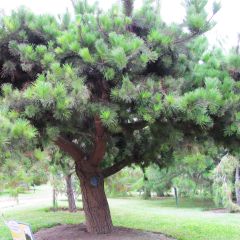
Pinus insignis - Monterey Pine
- Height at maturity 13 m
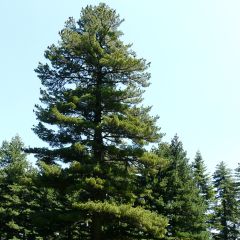
Pinus peuce - Macedonian Pine
- Height at maturity 20 m
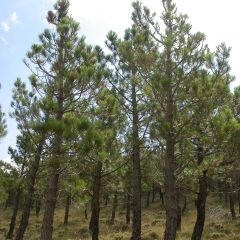
Pinus pinaster - Maritime pine
- Height at maturity 30 m
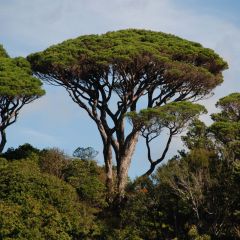
Pinus pinea - Umbrella pine
- Height at maturity 20 m
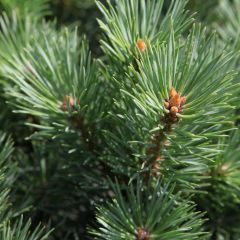
Pinus sylvestris Watereri - Scots Pine
- Height at maturity 2,50 m
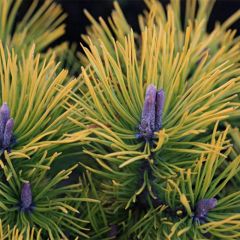
Pinus mugo Golden Glow - Dwarf Mountain Pine
- Height at maturity 1 m
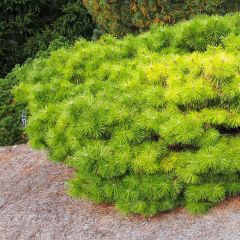
Pinus densiflora Jane Kluis - Japanese Red Pine
- Height at maturity 50 cm
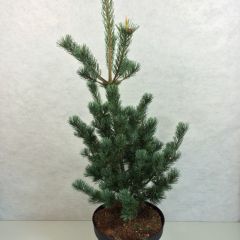
Pinus parviflora Azumi Goye - Japanese White Pine
- Height at maturity 3 m
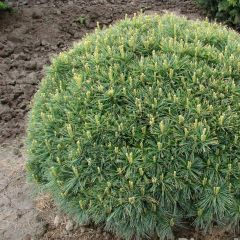
Dwarf Weymouth Pine - Pinus strobus Minuta
- Height at maturity 60 cm
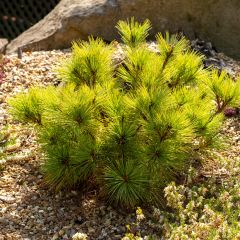
Pinus strobus Radiata - Eastern White Pine
- Height at maturity 1,75 m
Discover other Pinus - Pine
View all →Available in 2 sizes
Available in 1 sizes
Available in 1 sizes
Available in 2 sizes
Available in 2 sizes
Available in 2 sizes
Available in 1 sizes
Available in 1 sizes
Available in 2 sizes
Available in 1 sizes
Planting
Where to plant pine?
Accustomed to extreme conditions, pine will often do even better in a garden. Most species tolerate drought well, especially Mediterranean pines such as umbrella pine (Pinus pinea), Aleppo pine (Pinus halepensis) and Corsican laricio pine (Pinus nigra subsp. laricio). Very cold-tolerant species include Scots pine, Austrian black pine (Pinus nigra) and its dwarf form (Pinus mugo var. mughus). They grow in all soils, even poor, dry soils, but generally dislike waterlogged conditions in winter.
There are some exceptions, such as Weymouth pine, which does not tolerate excess lime, and Himalayan pine (griffithii), which requires fresh, deep soil. By the sea, Monterey pine (Pinus radiata) forms very effective windbreaks, as often seen along the Breton coast. This Californian pine from Monterey Bay, with a fairly massive silhouette, particularly likes mild, humid climates with soil that remains fairly cool. Along the Mediterranean coast, prefer Aleppo pine, more graceful with its fine grey-green needles and a trunk with silvery-grey fissured bark reminiscent of an elephant’s armour. Maritime pine suits conditions of the south Atlantic coast, both for its deep, sandy, cool-to-acid soils and for warm summers with mild winters. It also tolerates periods of drought once established.
Place pines preferably in full sun. Light shade is, however, tolerated in southern France. Hardiness varies by species: southern ones (Aleppo, umbrella, maritime) tolerate −12 to −16°C, while montane species such as Pinus nigra and Scots pine tolerate down to −35°C without problem.
Allow adequate spacing because tall-growing pines grow fairly quickly, unlike rockery pines. On a terrace, avoid placing dwarf conifers too close to a light-coloured wall, as reflected light can scorch them.
When to plant?
Preferably plant in September–October or early spring, especially in slightly heavy soils.
How to plant?
This plant is very easy to grow. Choose a well-branched specimen with a balanced silhouette and a leading shoot if you want a tree of large stature. Small rockery pines are valued for their twisted silhouette, giving the impression of a windswept cliff.
- Soak the root ball well before planting by immersing the pot in a bucket of water while you dig the hole.
- Dig a hole deep and three times wider than the root ball and loosen the soil around with the tines of a spade-fork. Avoid heavy, waterlogged ground in winter for most pines (exceptions: Pinus cembra, Pinus coulteri).
- Add a few handfuls of sand and gravel to ensure good drainage around the roots. In heavy soil, opt for planting on a mound or within a rockery.
- Add well-rotted manure or compost if soil is poor.
- Place the plant in the planting hole with 2 or 3 stakes driven deeply into the ground around the root ball.
- Replace the soil and firm lightly.
- Tie the trunk to the stakes with soft ties.
- Form a watering basin and water generously.
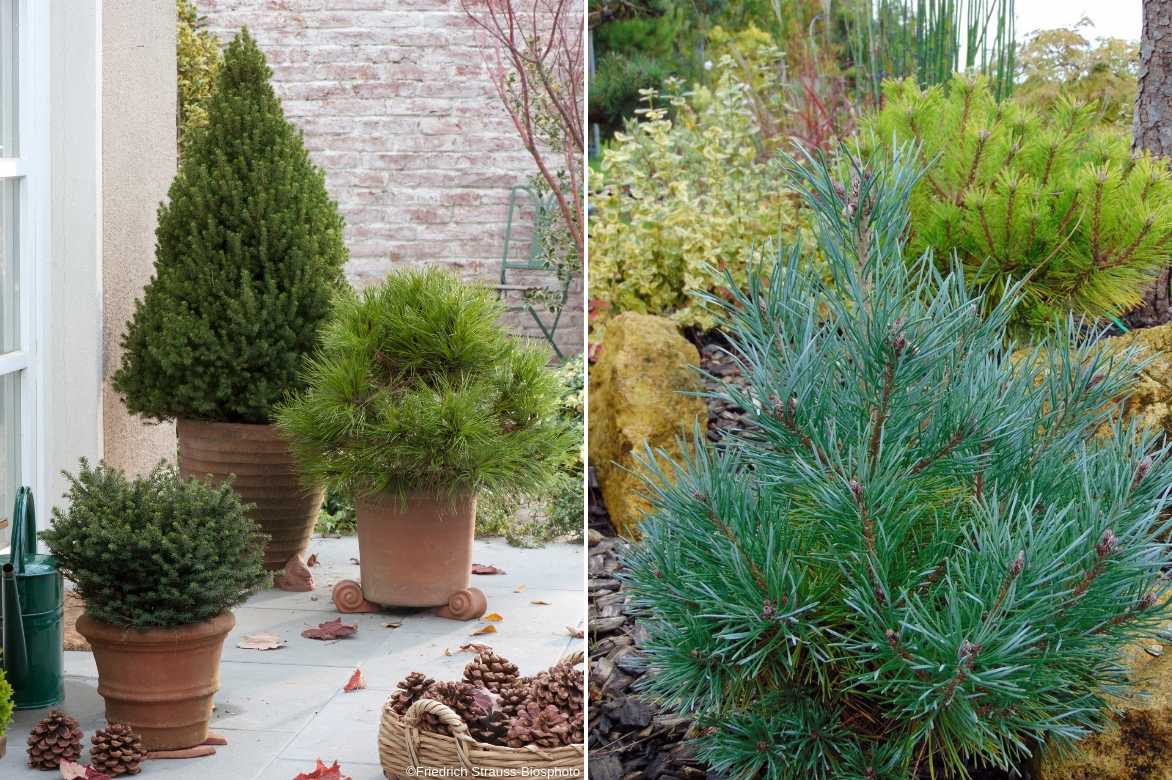
Conifers in pots: Picea abies ‘Nidiformis’, Picea glauca (e.g. ‘December’), Pinus nigra (e.g. ‘Pierrick Brégon’) / conifers in a rockery (Pinus strobus ‘Nana’ and ‘Radiata’)
Pruning and care
- Water generously during first years and during prolonged drought, especially for container plants.
- Optionally apply a “conifer” fertiliser at the start of growth each spring if you want to speed up growth.
- In winter, protect young fragile pines, such as maritime pine, with horticultural fleece.
Pine pruning
- Pruning dwarf rockery pine is very simple insofar as it is not necessary, but it can be done to give a cloud-like silhouette.
- On ball-shaped forms, you can reduce shoots by one third to give a more compact appearance.
- For large pines, limit yourself to gradually pruning the lower branches flush with the trunk until you reach the first scaffold branches. Then remove dead wood and small branches that grow inside the crown to clear the main branches and create “windows” to reduce windage.
→ Also see our advice sheet : “Cloud pruning or niwaki”
Main pests and diseases of pine
Pines are seldom seriously affected by disease unless a severe outbreak occurs in surrounding woods. The main pest of pine to combat is the pine processionary caterpillar which sometimes also attacks cedars, and can cause major damage by completely defoliating the tree. It is identified by the large silky nests formed in the branches and by columns of dark, villous caterpillars. These moth larvae have the drawback, in addition to feeding on the tree’s needles, of expelling urticating hairs at the slightest alarm, causing irritation of skin, eyes and airways, a real scourge for sensitive people as well as necrosis of the tongue and blindness in animals. Caterpillars leave the nest to feed on the needles then descend in single file to attack another pine or pupate in the soil at the end of winter.
→ for further reading: “Pine processionary caterpillar: dangers and control methods”
If you can reach the nest with a ladder or pole pruner, start by covering up well (gloves, goggles…) and work on a calm, very cold day. Cut the branches bearing the nests. Then soak them in a bucket of water with washing-up liquid for a few hours. Bury nests deeply or burn them after allowing them to dry. If you burn nests containing live caterpillars, you risk a massive release of hairs. The other solution is to apply, according to tree height, a biological treatment based on Bacillus thuringiensis, effective at all larval stages.
Chermes is an aphid that produces galls appearing as whitish swellings on pine shoots. Apply mineral oil to the trunk at the end of winter. Pine rust causes red spots on needles or stems that develop into white vesicles or may curve the tree’s leading shoot. On young trees, apply Bordeaux mixture in early summer. The tortrix (leafroller) is also a caterpillar that twists pine shoots. Cut and burn affected shoots in spring.
Propagation
Most common method of propagation is sowing, as propagation by cuttings is virtually impossible, but varieties are generally grafted to preserve their characters, which requires specialist work.
Sowing
Collect any natural sowings you can find in spring following cone fall.
Do not wait too long to transplant young plants, as pine dislikes having its roots disturbed.
Presence of a symbiotic fungus is sometimes necessary for pine development. If soil does not contain any, add a handful of decomposing needles from the same pine species, collected in a forest or at the base of a vigorous mature specimen.
Uses and companion plants
Pine is a tree usually formed of a single trunk that looks splendid when planted as a specimen, or in groups of three at edges of surrounding countryside, in a naturalistic garden.
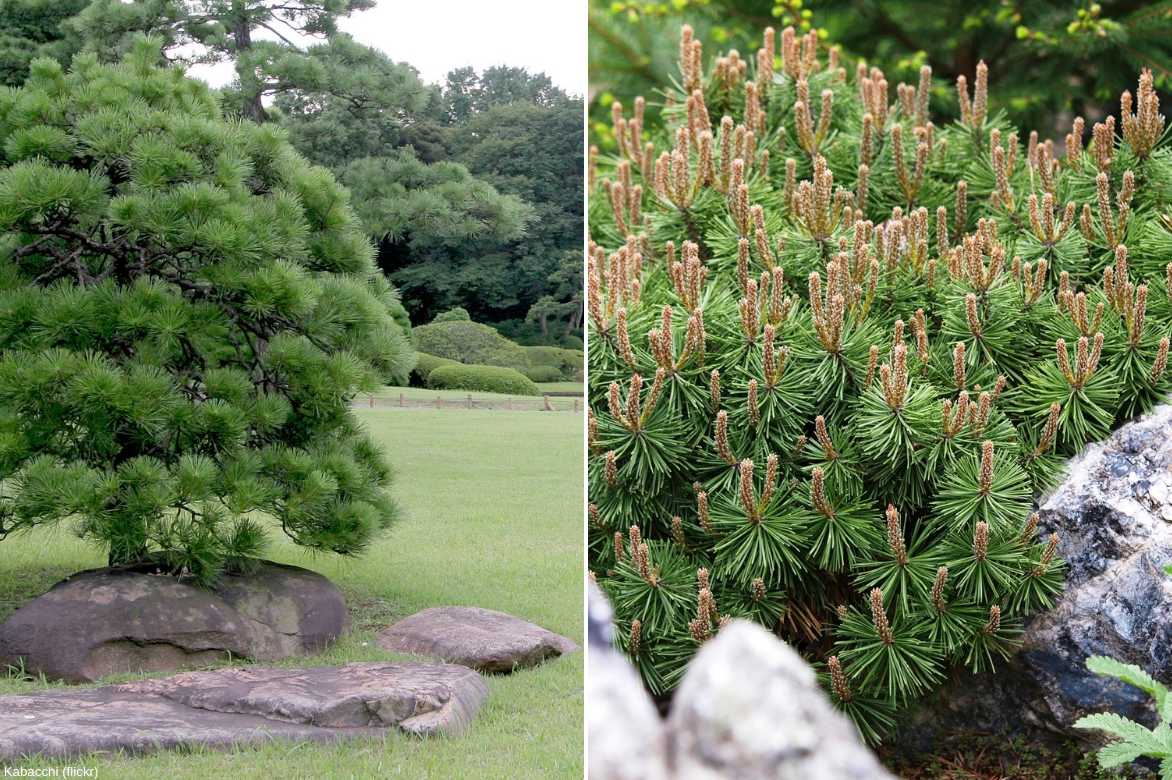
Pine as specimen / Pinus mugo ‘Mops’ in rockery
Dwarf forms are showcased within a large rockery or in a contemporary garden defined by strong geometric lines, around pools or masonry features. Several dwarf conifers can be combined with a prostrate habit (Juniperus horizontalis ‘Blue Chip’), globose (Picea abies ‘Little Gem’), or columnar (Juniperus communis ‘Sentinel’). The true graphic qualities of conifers naturally assert themselves in the design of a contemporary garden, which favours aesthetics of form, silhouette and texture over the parade of flowering. These very much alive plants, with reassuring permanence, provide long-lasting structure to a bed, define paths, edge the terrace, easily replacing the strong presence of clipped box or holly. It’s all about playing with volumes and colours.
However dwarf conifers have a strong presence that can be balanced with light, graceful, rather “wild” plants such as grasses, ferns, hardy geraniums. Use yellow tones to brighten dark masses of pines with Spanish broom (Genista hispanica), golden alyssum (Alyssum saxatile), euphorbia (Euphorbia epithymoides) or lady’s mantle (Alchemilla mollis) with its airy habit.
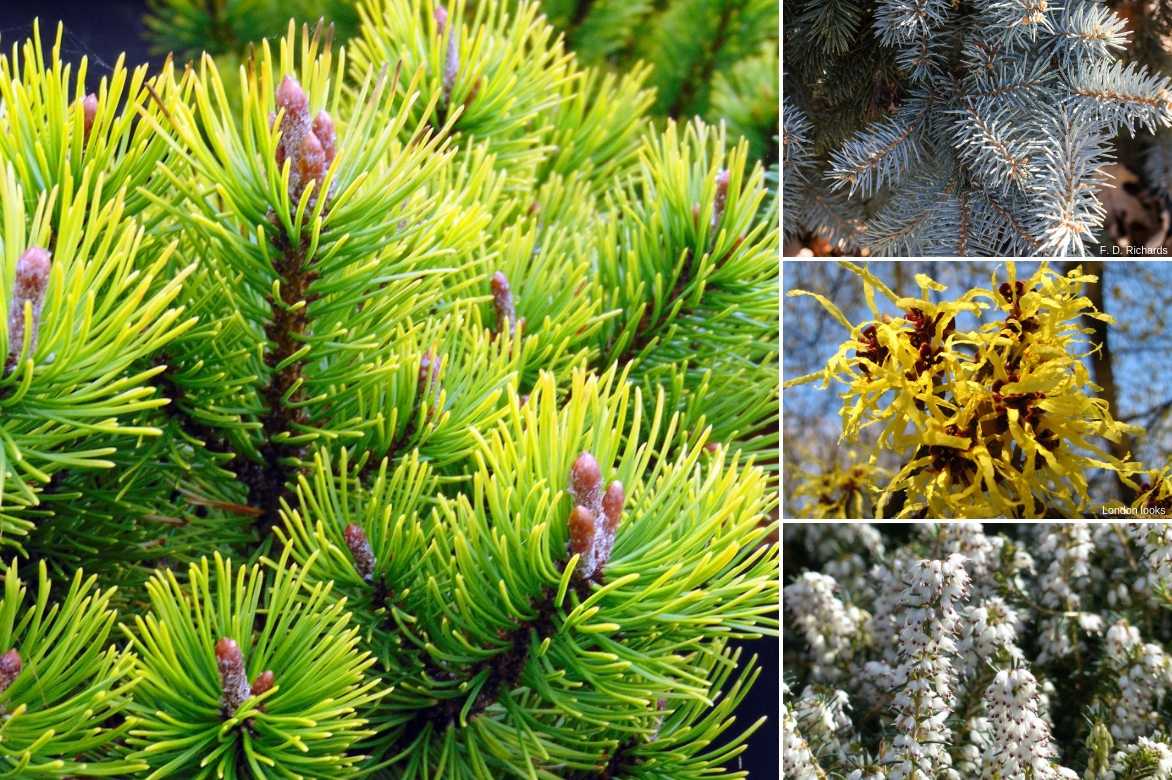
A winter planting idea: Pinus mugo ‘Ophir’, Picea pungens (‘Jeddeloh’, ‘Thuem’ or ‘Glauca Globosa’), Hamamelis mollis ‘Pallida’ and Erica x darleyensis ‘Silberschmelze’
Create bold contrasts by pairing Pinus mugo ‘Mops’ with heathers, Japanese azaleas, clipped or not, or with colourful groundcover plants such as Lysimachia nummularia ‘Aurea’, variegated periwinkle (Vinca minor ‘Variegata’), Aegopodium podagraria ‘Variegata’.
You can insert bulbs that will surprise in spring such as daffodils, squills, bluebells. Easy perennials with compact, architectural growth like euphorbias or artemisias can complete the picture.
Also read Gwenaëlle’s tips in Designing a garden under pines !
Did you know?
Oldest trees encountered on Earth, excluding specimens originating from a single clone, are Bristlecone pines (Pinus longaeva) nearly 5,000 years old. These trees, which grow at high altitude directly on rock close to glaciers, have experienced extremely slow growth and display a short, gnarled trunk largely composed of dead wood, with short, very densely packed needles and cones coated in resin.
Learn more
Discover our range of Pines: from smallest varieties to large trees, a selection for every garden
Discover our selection of conifers for a Mediterranean garden
Discover Sophie’s advice sheet: 7 trees for a seaside garden and Gwenaëlle’s advice sheet: plants resistant to sea spray
Find out more about trees with umbrella habit
Our advice sheet: 10 conifers for a south-facing garden
Our summer series on travelling plants: Wollemi pine
Also discover 7 Mediterranean trees in our advice sheet
Find out more about pine needles with our article: Pine needles and soil acidity: a myth debunked
- Subscribe!
- Contents
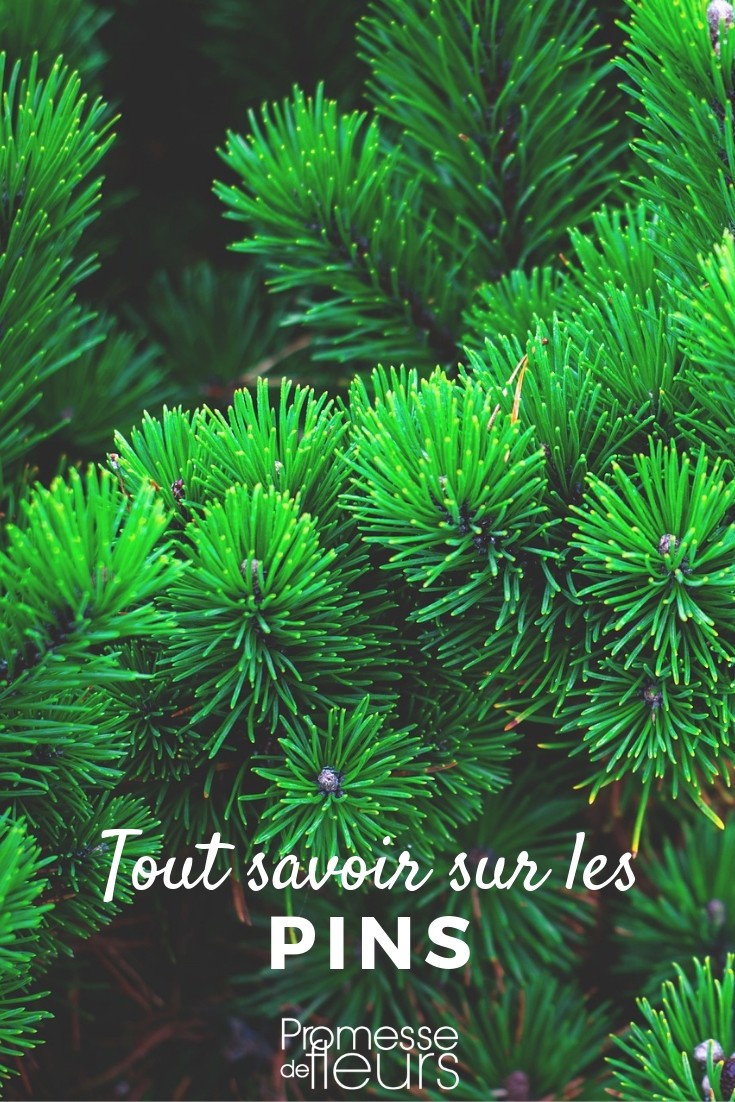































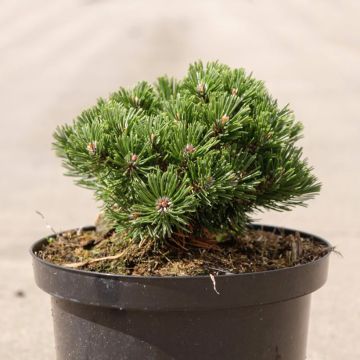

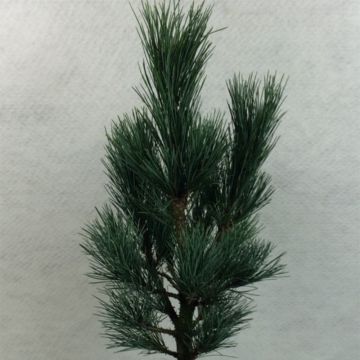
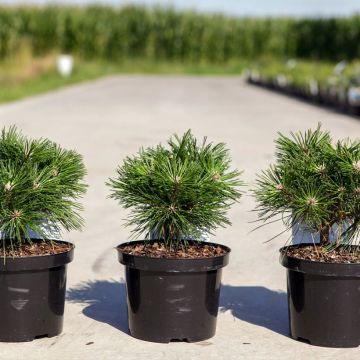
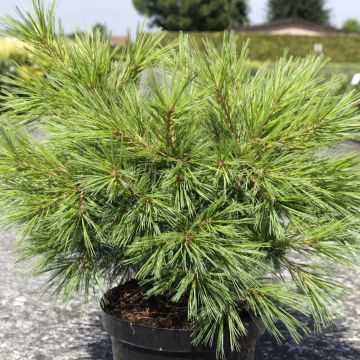
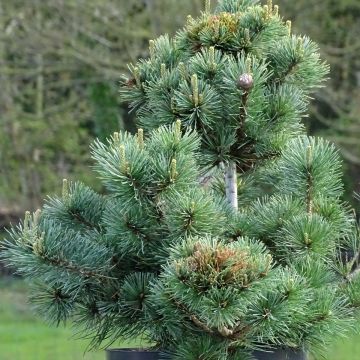

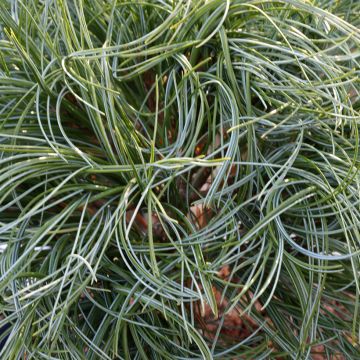
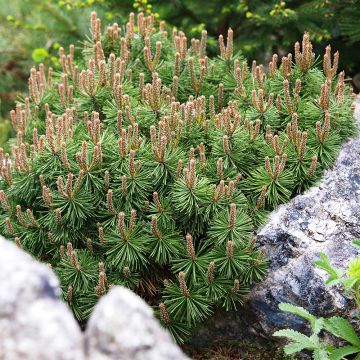
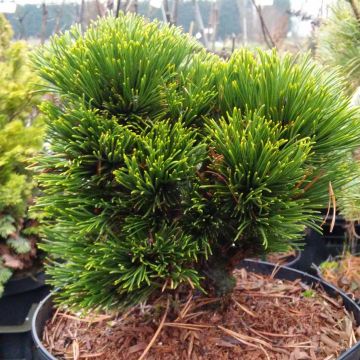
Comments